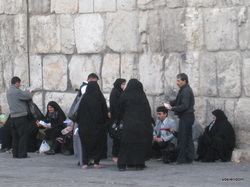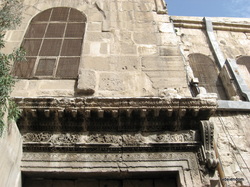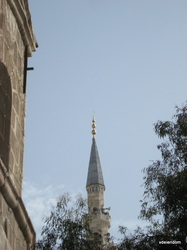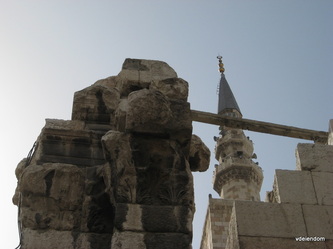The campsite owner explains to us where to go to pick up a minibus that will take us to the center of Damascus. We get into a bus whose driver nods his head when Willie shows him the map and point to center. All eyes on the bus are on us – I feel on me more for different reasons: maybe because I do not wear a covering, I’m blond or gray and I look and dress different. I can understand why if you look at the women in the street. 95% of them wear headscarves, a smaller percentage the full veil or burkha. I do want to be sensitive and I did bring head scarves, but the British girl whom I met told me that she entered the Syrian border post building with a headscarf and the tourist assistant came to her and asked whether she is Muslim. When she said no, he told her that she should not wear a headscarf, she is a tourist. So it remains confusing to me and I try to be as discreet as possible.
Friday in Syria is definitely Holy Day – Day of Prayer – far more so than what we’ve seen in Turkey. Almost all the stores are closed and the streets are strangely quiet. I have to say I enjoy the more peaceful atmosphere and tranquility. Your personal space bubble inflates some and I can enjoy looking around rather than trying to negotiate your way through the crowds.
We find the famous Souq that takes you right to the Great Mosque. Here and there a vendor is out selling clothes, pastries, vegetable peelers, or children’s toys.
Friday in Syria is definitely Holy Day – Day of Prayer – far more so than what we’ve seen in Turkey. Almost all the stores are closed and the streets are strangely quiet. I have to say I enjoy the more peaceful atmosphere and tranquility. Your personal space bubble inflates some and I can enjoy looking around rather than trying to negotiate your way through the crowds.
We find the famous Souq that takes you right to the Great Mosque. Here and there a vendor is out selling clothes, pastries, vegetable peelers, or children’s toys.

There are many people, men and women dressed in black lingering around the mosque – waiting to enter There are noticeably more families out – father, mother with children – everyone smartly dressed, other than during the workweek when you see mostly men out on the streets.
We walk around the mosque which has a long history. I discovered interesting facts about the Great Umayyad Mosque. It is considered, alongside Jerusalem’s Dome of the Rock as one of the most holy shrines of early Islam. It was originally a pagan temple to Hadad, local Semitic god of storms; the Romans reused the site to build a colossal temple to Jupiter. With the advent of Christianity the temple was converted to a cathedral dedicated to John the Baptist, whose tomb still lies within the mosque. In 636 the Arabs conquered Damascus and the mosque was used by Christians and Muslims who directed their prayers towards their spiritual homes. As the Muslim population grew a Caliph decided that the mosque should become only Muslim and in exchange for the mosque he gave the Christians four other sites in the Old City where churches were to be erected.
Syria played a key role in the evolution of mosque architecture.
The Kaába at Mecca was Islam’s first monument, but it consisted merely of the holy stone which was circumambulated. After Muhammed’s death the Calif spent a huge amount of money on the construction and beautification of the Great Umayyad Mosque. It was his goal to show the newly Christian subjects that Islam could outdo Christianity, creating a building with representations of Paradise that exceeded any previous Christian monument.
Minarets were first used in Damascus at the Great Mosque. Before minarets were built the Muslims would climb on the roof to make the call to prayer., but here they recognized the benefit of extra height.
Islam furthermore forbids the use of the human form in all decorative art, so verses of the Koran were used instead, embellished in exotic calligraphic styles, along with foliage, trees and geometric patterns
Domes, often characteristic of a mosque’s architecture gives a honeycomb effect – symbolizing the honey the believer is promised in Paradise.
As we walked around the mosque we find the now blocked-up gate which was the shared Muslim and Christian entrance. An elaborate lintel with a Greek inscription is above the blocked gate.
Syria played a key role in the evolution of mosque architecture.
The Kaába at Mecca was Islam’s first monument, but it consisted merely of the holy stone which was circumambulated. After Muhammed’s death the Calif spent a huge amount of money on the construction and beautification of the Great Umayyad Mosque. It was his goal to show the newly Christian subjects that Islam could outdo Christianity, creating a building with representations of Paradise that exceeded any previous Christian monument.
Minarets were first used in Damascus at the Great Mosque. Before minarets were built the Muslims would climb on the roof to make the call to prayer., but here they recognized the benefit of extra height.
Islam furthermore forbids the use of the human form in all decorative art, so verses of the Koran were used instead, embellished in exotic calligraphic styles, along with foliage, trees and geometric patterns
Domes, often characteristic of a mosque’s architecture gives a honeycomb effect – symbolizing the honey the believer is promised in Paradise.
As we walked around the mosque we find the now blocked-up gate which was the shared Muslim and Christian entrance. An elaborate lintel with a Greek inscription is above the blocked gate.
To enter the mosque courtyard we had to shed our shoes and I received a full length robe with hood to cover my hair. The courtyard was bustling with activity and it is interesting that I feel a strong constraint: Watching the reverence, the piety of the worshipers make we want to retreat. Taking photos of people, regardless of religion, feels invasive although many Syrian looking people are taking pictures and videos, and it does not seem to bother anyone. I leave the photography part to Willie as I sit down just to observe. It is difficult to find words for what I’ve seen: such seriousness; such devotion; such sincerity…in different places in the huge prayer hall small groups of men are gathered around their spiritual leader who delivers his message very passionately eliciting strong emotional reactions from his listeners: many of them cry as they listen with intent. Outside the railing a group of women (women are not allowed inside the railing) dressed in black and fully veiled sit on the carpet to listen to the spiritual leader. I wish I could understand, but it is of course all in Arabic.
The tomb of John the Baptist is in the Prayer Hall and are visited by hundreds of people, mainly women. They kiss the bronze railing as they pray with fervor in front of the tombstone.
The tomb of John the Baptist is in the Prayer Hall and are visited by hundreds of people, mainly women. They kiss the bronze railing as they pray with fervor in front of the tombstone.
The tallest minaret is called the Tower of Jesus and the Muslim tradition holds that it is here where Jesus will descend when He comes again to judge the Anti-Christ – a fascinating coming together of different worlds , belief and religion which I have to be honest creates more questions than answers and inner turmoil.
We continue our tour of the very quiet Old Town. A few more stores in the souqs surrounding the mosque are open and I am drawn to the beautiful colors and aromas flowing from the spice and homemade soap stalls.
We both want to go to the bathroom and to do that we had to find a café where we could drink a cup of tea! It still costs us money to use the facilities in spite of the tea! English speaking visitors tell us where we can find an ATM and internet cafè, which is as difficult as to find chicken teeth! (an Afrikaans saying we have: ‘skaars soos hoendertande”)
We both want to go to the bathroom and to do that we had to find a café where we could drink a cup of tea! It still costs us money to use the facilities in spite of the tea! English speaking visitors tell us where we can find an ATM and internet cafè, which is as difficult as to find chicken teeth! (an Afrikaans saying we have: ‘skaars soos hoendertande”)



 RSS Feed
RSS Feed
